The Brussels Griffon, or ‘Griff’ as they are affectionately known, is a captivating small dog breed with a personality that belies its diminutive size. With their human-like expressions and mischievous charm, these dogs have carved out a unique place in the hearts of many.
As an intelligent toy breed, Brussels Griffons boast a rich history that stretches back to 19th century Belgium. They were bred from various terriers and spaniels to keep stables free of vermin. A breed with royal connections, their popularity received a significant boost from Queen Marie-Henriette’s endorsement.

Despite their fairytale-like rise to fame, Brussels Griffons are down-to-earth companions that thrive on interaction and display a lively and playful nature. They are characteristically smart and alert, making them excellent watchdogs despite their small stature.
Their distinctive appearance, complete with a beard and large, soulful eyes, complements their hearty personality. While they might be small, they pack a punch when it comes to their presence in the home, demanding attention and showing devotion to their human counterparts.
Key Takeaways
- Brussels Griffons are a small, intelligent breed with a rich heritage and royal ties.
- Griffs possess emotive faces and a lively spirit, ideal as attentive and playful companions.
- Due to their size and traits, they require specific care and suit a range of family environments.
Origin and History

When you explore the Brussels Griffon breed, you uncover a rich history that began in Belgium. These small, charming dogs have roots that trace back to the early 1800s and have delighted dog lovers for centuries.
Breed Evolution
The breed that you know today as the Brussels Griffon, or Griffon Bruxellois, originated in Belgium. In the 1800s, these dogs were primarily bred for their ratting ability. The small terrier-types were owned by coachmen, who used them to keep the stables free of rodents.
The city of Brussels is so prominent in the breed’s history that it lent its name to the Griffon.
Through selective breeding, the modern-day Brussels Griffon was developed from a blend of several breeds, including the Affenpinscher and possibly the Pug or English Toy Spaniel.
By the late 1800s, this breed gained more attention, particularly after Queen Henrietta Maria of Belgium became a patron of these dogs. The queen’s influence was significant enough that it ensured the breed’s survival and desirability.
Key Historical Points:
- Origin: Belgium
- Breeding Purposes: Ratters in the stables during the 1800s
- Development: Mixed with breeds like the Affenpinscher, Pug, and English Toy Spaniel
- Royal Boost: Popularity increased with Queen Henrietta Maria of Belgium’s endorsement
Your insight into the Brussels Griffon’s origin and history gives you a glimpse of a breed that has endured through time, evolving from a scruffy ratter to a beloved companion with a regal touch.
Breed Characteristics
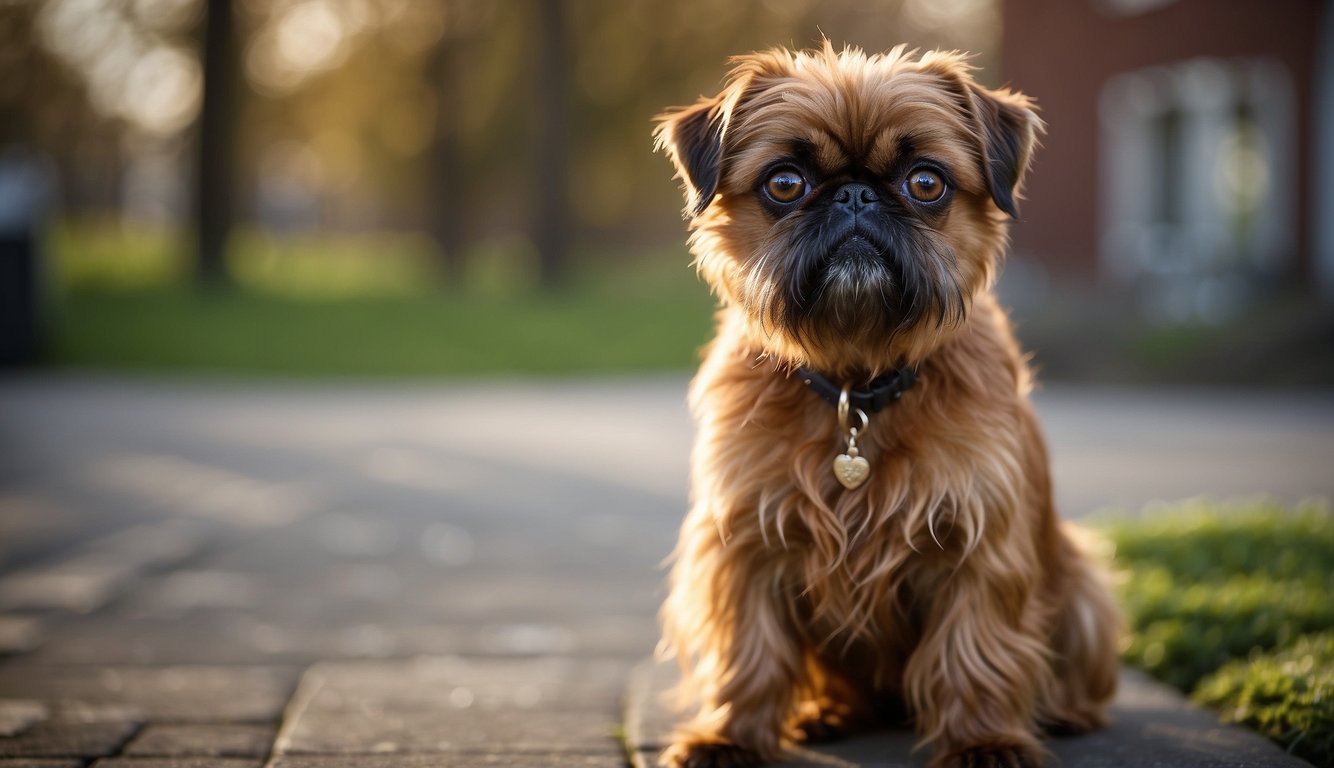
The Brussels Griffon, with its distinctive appearance and lively character, makes a remarkable companion. Understanding their physical attributes, coat varieties, and the color spectrum is vital in appreciating this unique breed.
Physical Attributes
Your Brussels Griffon is a small yet sturdy toy breed with a lot of personality packed into their compact frame. Here are some specifics:
- Size: Though petite, they have a strong bone structure.
- Weight: Typically ranges from 8-10 pounds.
- Height: Between 9-11 inches at maturity.
- Traits: Expect a short nose and human-like expressions combined with a confident demeanor.
- Energy Level: They are playful and energetic without being overly demanding.
Coat Varieties
Brussels Griffons come in two distinct coat types – each with its own grooming needs.
- Smooth-Coated: Known as the Petit Brabançon, this variety has a slick, glossy coat that lies close to the body.
- Rough-Coated: This type sports a wiry and dense coat with a distinctive beard around the face.
Both varieties require regular grooming, but your rough-coated Griffon will need more frequent brushing to prevent matting.
Color Spectrum
The vibrant hues of your Brussels Griffon’s coat are as charismatic as their personality. The breed standard recognizes several colors:
- Red: Ranging from rich mahogany to a lighter red, often with a little black at the whiskers and chin.
- Black: A deep, jet black hue across the entire body.
- Black and Tan: A striking combination where black serves as a backdrop for distinct tan markings.
It’s your responsibility to ensure their coat is kept clean and well-groomed, regardless of the color, to maintain their dapper look.
Temperament and Personality
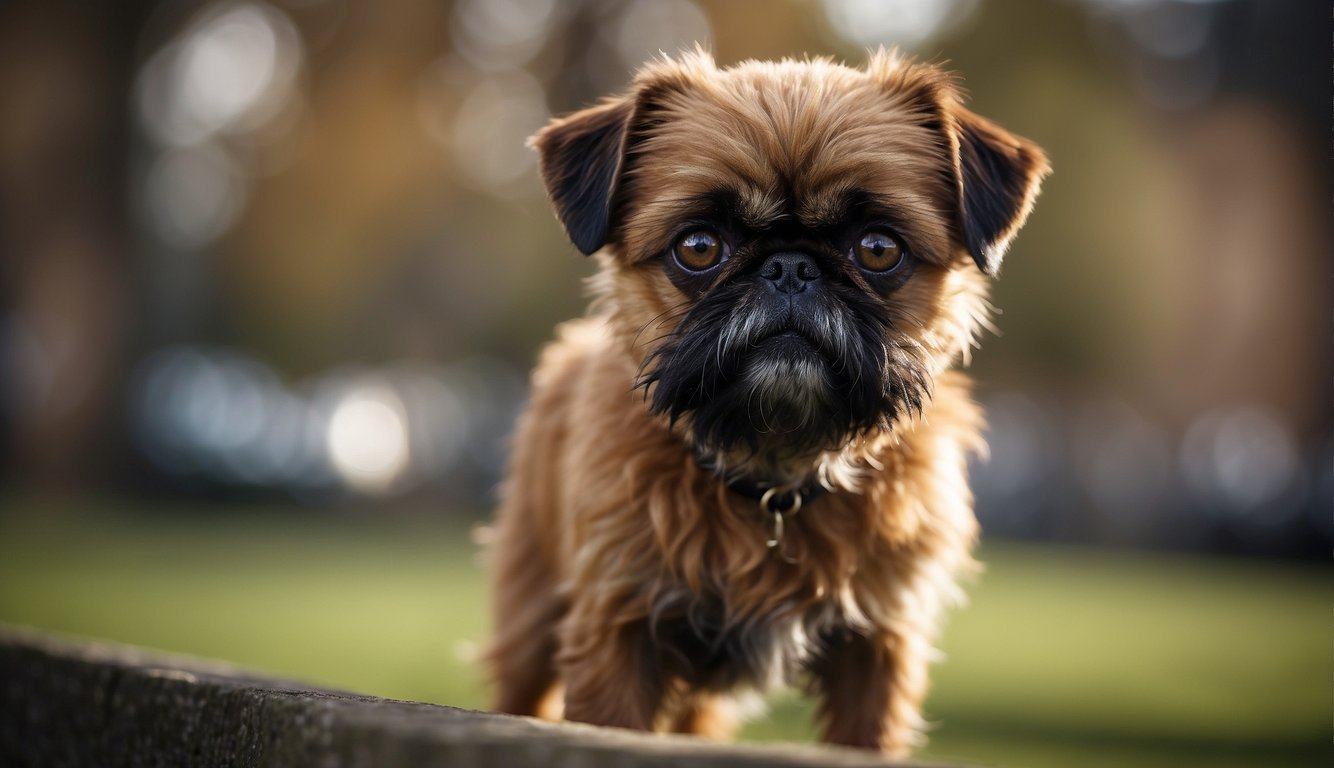
In understanding the Brussels Griffon, you will find that their temperament is as distinctive as their appearance. These dogs are known for their complex personalities, which blend alertness and sensitivity, with a propensity for playfulness and loyalty.
Behavioral Traits
Brussels Griffons possess a dynamic temperament making them active and alert at home. You’ll notice their sensitive nature in response to their environment and to your emotions.
Known for their stubborn streak, training requires consistency and patience.
- Curiosity: Always inquisitive, they love to explore their surroundings.
- Playfulness: They enjoy engaging in playful activities, providing entertainment and bonding time.
- Loyalty: Griffons develop deep bonds with their owners and can be quite affectionate.
Trainability: Despite their occasional stubbornness, they are intelligent and can learn commands and tricks with the right approach. Positive reinforcement works best.
Social Attitudes
Your Brussels Griffon’s social behavior can vary. While they are inherently sociable around their family, early socialization is key in developing a well-rounded temperament.
- Children: With proper introduction and mutual respect, they can be good with children who are gentle and considerate.
- Sociability: Griffons may be cautious or shy around new people, but they usually warm up once they feel safe.
- Other Pets: They can get along with other family pets, especially when raised together, but they will assert themselves if they feel their space is threatened.
Health and Lifespan

When considering bringing a Brussels Griffon into your life, understanding their health and expected lifespan is crucial. This sprightly breed has a life expectancy of 12 to 15 years, but like all dogs, they have their share of breed-specific health concerns.
Common Health Issues
Brussels Griffons are generally healthy, but they have predispositions to certain health conditions that you should be aware of.
- Brachycephalic Syndrome: Their short-nosed (brachycephalic) facial structure can cause breathing problems.
- Eye Problems: Large, prominent eyes may lead to issues such as cataracts or progressive retinal atrophy.
- Luxating Patella: A common condition where the kneecap dislocates or moves out of its normal location.
It’s important to keep routine veterinary appointments to catch and manage these conditions early.
Care for Longevity
To help your Brussels Griffon live a long and healthy life, consider the following care tips:
- Weight management: These dogs can easily become overweight, which exacerbates health problems, especially those affecting their joints and breathing.
- Regular Exercise: Balanced daily exercise can help maintain cardiovascular health and keep them at an optimal weight.
- Eye Care: Regularly check their eyes for any signs of irritation or abnormal discharge and consult your vet if you have any concerns.
- Dental Hygiene: Practice good oral care to prevent dental issues, which could affect their overall health.
Grooming and Care

Taking care of your Brussels Griffon requires regular grooming and attention to their basic care needs. Proper maintenance will keep your dog healthy and looking their best.
Basic Care Needs
Your Brussels Griffon needs consistent basic care to stay happy and healthy.
Exercise is crucial; ensure your little companion gets daily walks and play sessions to meet their exercise needs. They don’t require extensive exercise, but enough to keep them fit and prevent boredom.
Shedding is minimal with this breed, making them a good choice if you prefer less fur around the house. Still, routine care is important.
Keep their nails trimmed to prevent issues with walking, and provide dental hygiene to maintain overall health. Regular ear checks will help prevent infections.
Grooming Essentials
Proper grooming is essential to your Brussels Griffon’s well-being. It also establishes a bond between you and your furry friend.
Here’s a simple grooming routine to follow:
-
Brushing: Aim to brush your dog’s coat several times a week. This helps to remove dirt and loose hair, and to prevent matting.
-
Bathing: Bathe your Griffon as needed — typically once a month. Use dog-formulated shampoo to keep their skin healthy.
-
Clipping: Hair clipping may be necessary, particularly around the face to avoid overgrowth that can interfere with their vision.
-
Stripping: For certain coat types, like the rough coat, hand-stripping is preferred over clipping. Hand-stripping involves removing dead hair by hand or with a stripping tool. This helps maintain the coat’s texture and color.
Remember to handle your dog gently during grooming sessions. Also, use these moments to check for any signs of skin issues or parasites. Regular grooming keeps your Brussels Griffon clean, comfortable, and allows you to spot any health issues early on.
Training and Exercises
When training your Brussels Griffon, harnessing their intelligence and eagerness to please will make the process enjoyable for both of you. Consistent training techniques coupled with suitable exercise routines are key to keeping your energetic Brussels Griffon both mentally and physically stimulated.

Training Techniques
Your Brussels Griffon is highly intelligent and generally easy to train, but they do require consistent and patient training methods. Positive reinforcement works best with this breed. Praise and treats make excellent rewards for obedience and can help emphasize good behavior. Here are some specific training pointers:
- Start Early: Begin training your puppy as soon as you bring them home. This sets the foundation for future learning.
- Keep Sessions Short: Short, engaging training sessions help maintain your dog’s attention.
- Socialization: Introduce your Brussels Griffon to a variety of people, pets, and situations early on. This will encourage well-rounded behavior.
Exercise Routines
Brussels Griffons are quite energetic for their size, and they thrive on daily activities. Though their exercise needs are not as demanding as larger breeds, neglecting their physical activity can lead to behavior issues due to pent-up energy. Here’s how you can keep your pet active and content:
- Daily Walks: Aim for at least 30 minutes of walking per day. You can split this into two shorter walks if preferred.
- Play Time: Engage in play that stimulates both their body and mind. Fetch and hide-and-seek can be great games.
- Agility Training: Consider agility training to provide physical and mental stimulation. Your Griffon’s nimble nature makes them well-suited for this activity.
Compatibility with Families
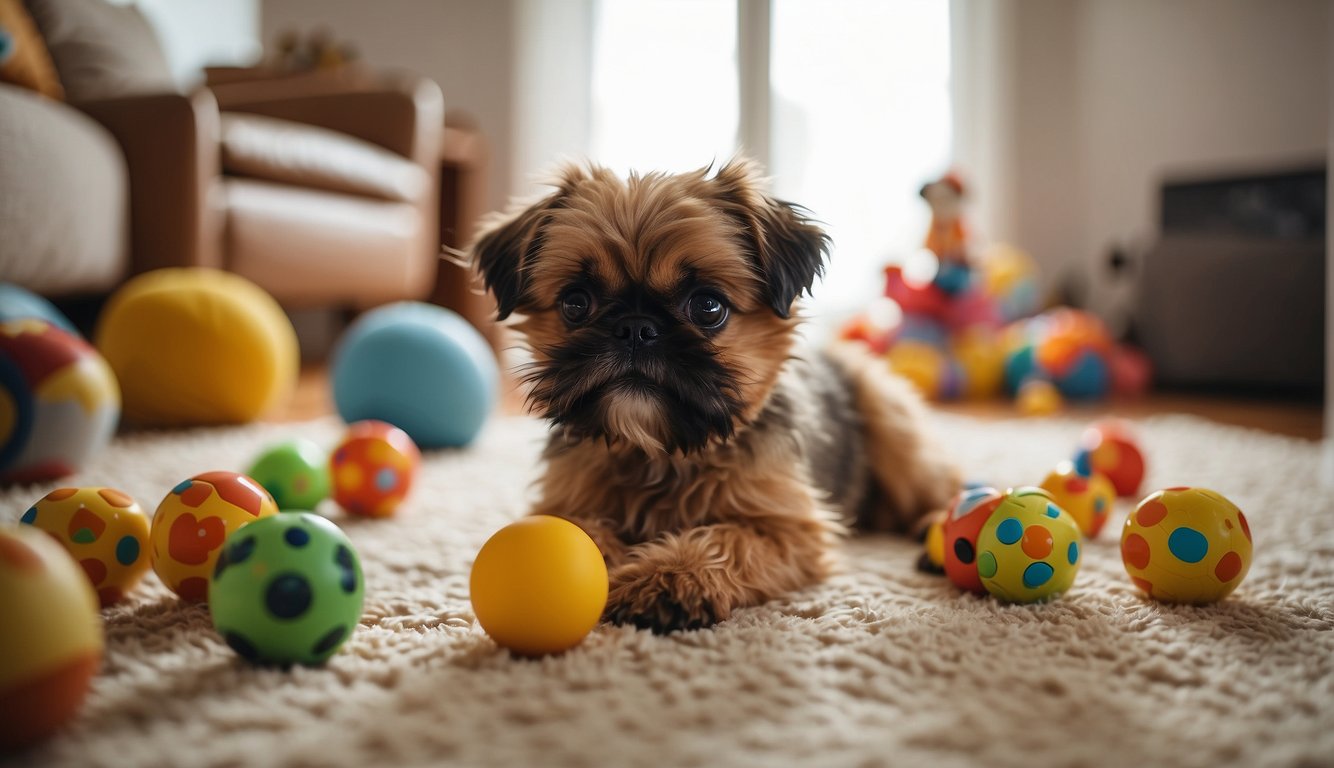
When considering a Brussels Griffon as your family dog, it’s important to understand their behaviors and needs to ensure harmonious integration into your household.
Interaction with Children and Other Pets
The Brussels Griffon is generally good with children, particularly families with older children who understand the need for gentle handling. These dogs can form strong, affectionate bonds with all members of the family. To help ensure positive interactions:
- Children: Teach your children to approach your Brussels Griffon calmly and handle them with care. Rough play could be harmful due to the dog’s small size.
- Other Dogs: Brussels Griffons tend to coexist well with other dogs, especially if they are of similar size. Still, it’s always wise to supervise initial encounters.
- Cats: They can live peacefully with cats, especially if they are raised together. Early socialization is key to promoting mutual understanding and respect between the species.
Owners should remain engaged in their Brussels Griffon’s social experiences, encouraging polite manners and intervening when necessary. Being part of the toy group, these dogs often thrive on companionship and can be prone to separation anxiety. So, consider this breed if you can provide plenty of attention and family interaction.
Diet and Nutrition
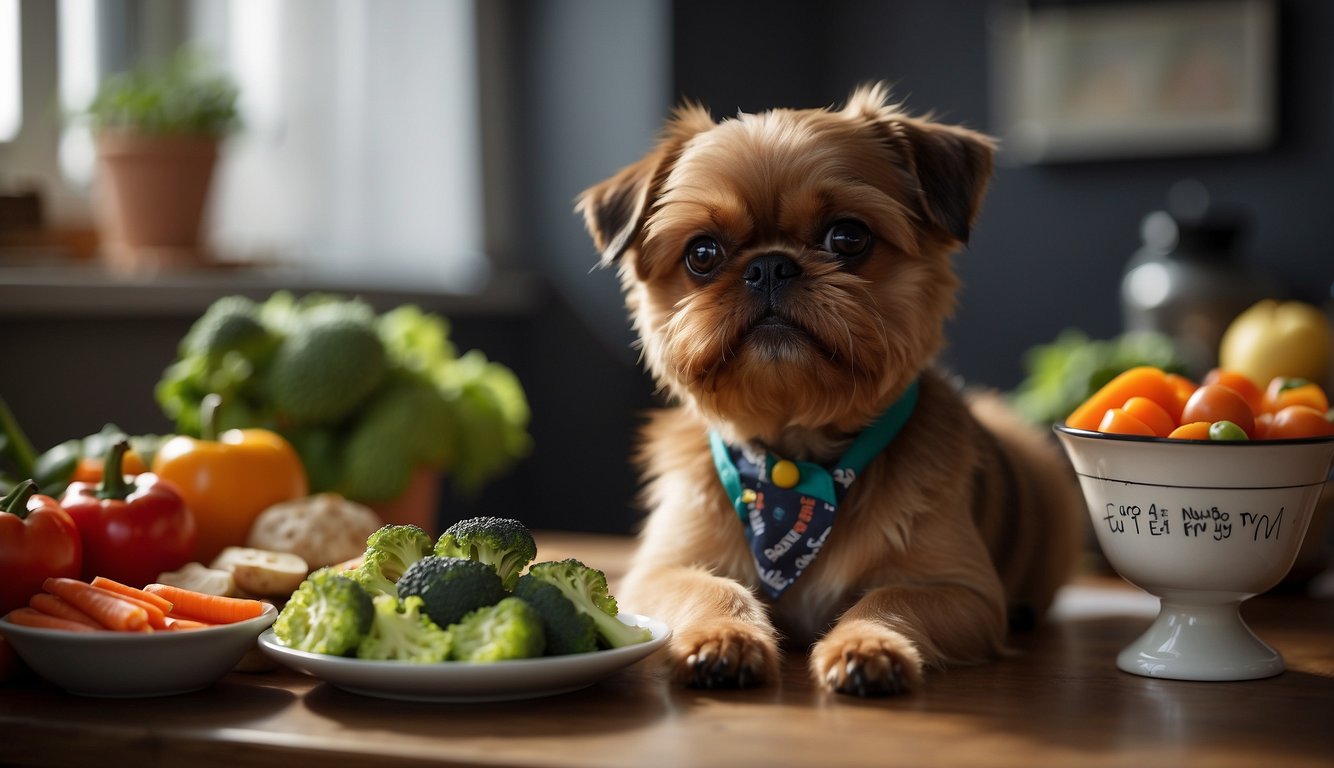
When planning your Brussels Griffon’s diet, it’s important to focus on quality and balance to meet their nutritional needs. As a small breed, they have a fast metabolism, meaning small, frequent meals are better than one large meal per day.
What to Feed:
- High-quality dog food: Look for brands that offer formulas specifically for small breeds. They are crafted to support their energy levels and smaller jaws.
- Whole proteins: Ingredients like chicken, fish, or beef should be at the top of the ingredients list.
- Essential nutrients: Your dog’s food should have a mix of protein, fats, carbohydrates, vitamins, and minerals.
Feeding Schedule:
- Puppies: Feed them 3-4 times daily.
- Adults: Move to 2 times daily to maintain optimal weight.
Treats and Snacks:
- Treats can be a good reinforcement during training but should be given sparingly to prevent weight gain.
- Limit treats to 10% of daily calorie intake.
Water Intake:
Ensure continuous access to fresh water to keep them well-hydrated.
Avoid:
- Overfeeding and human food high in fat and sugar can lead to obesity and health issues.
Monitoring:
Keep an eye on your Brussels Griffon’s weight and adjust portions as necessary. Your veterinarian can provide guidance on the appropriate amount of food your dog needs based on age, weight, and activity level.
Breed Popularity
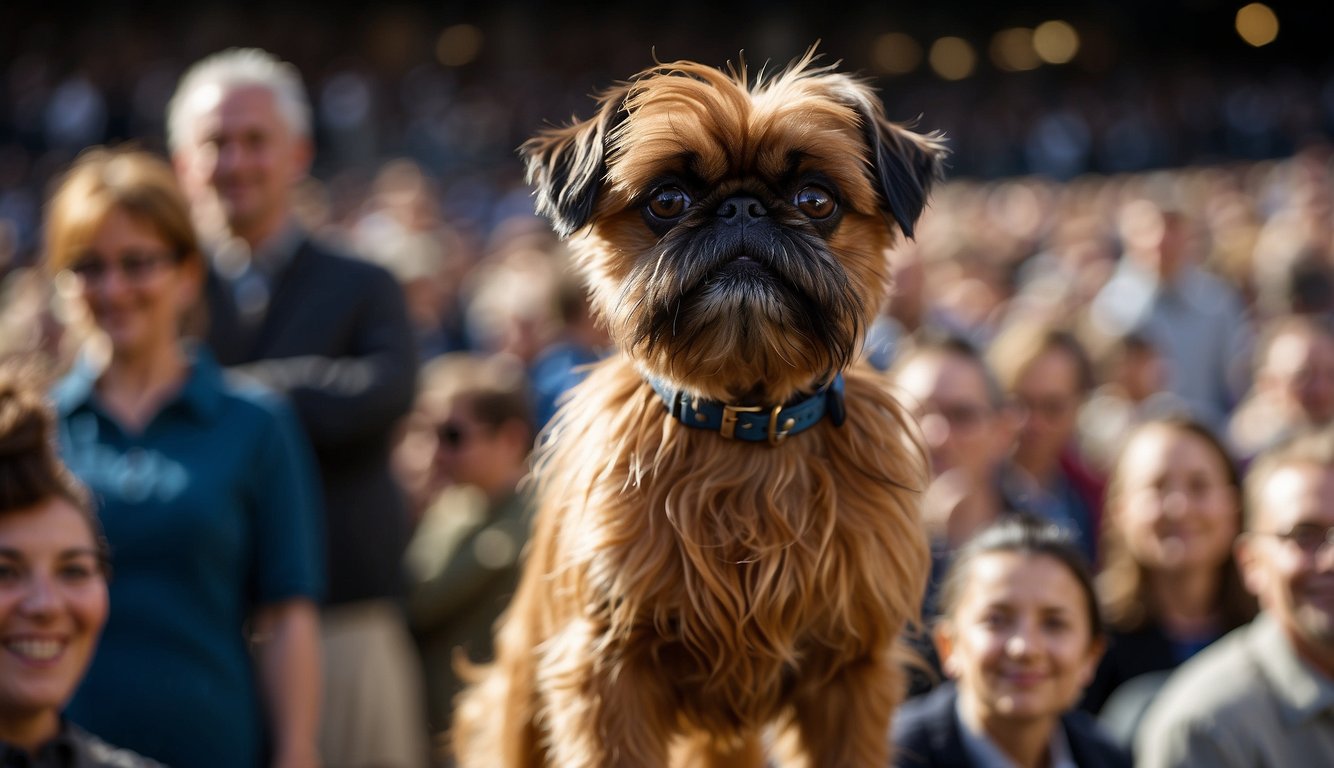
Your appreciation for the Brussels Griffon, affectionately known as the Griff, reflects a growing trend. These small toy breed dogs boast a lively personality that has garnered them a special place in the hearts of dog enthusiasts worldwide.
Recognition and Clubs
The American Kennel Club (AKC) fully recognizes the Brussels Griffon. This recognition highlights the breed’s prominence and the specialized care that goes into maintaining its unique characteristics. The AKC categorizes the Griff as part of the Toy Group, which underlines their compact size and companionable nature.
Additionally, dedicated breed clubs exist to support Brussels Griffon lovers like you. These clubs often provide resources and community events that allow owners to share their experiences and increase the breed’s exposure. If you’re looking to connect with other Griff enthusiasts, joining a breed club can be a fantastic way to immerse yourself in the world of these expressive and lovable dogs.
Choosing a Griffon
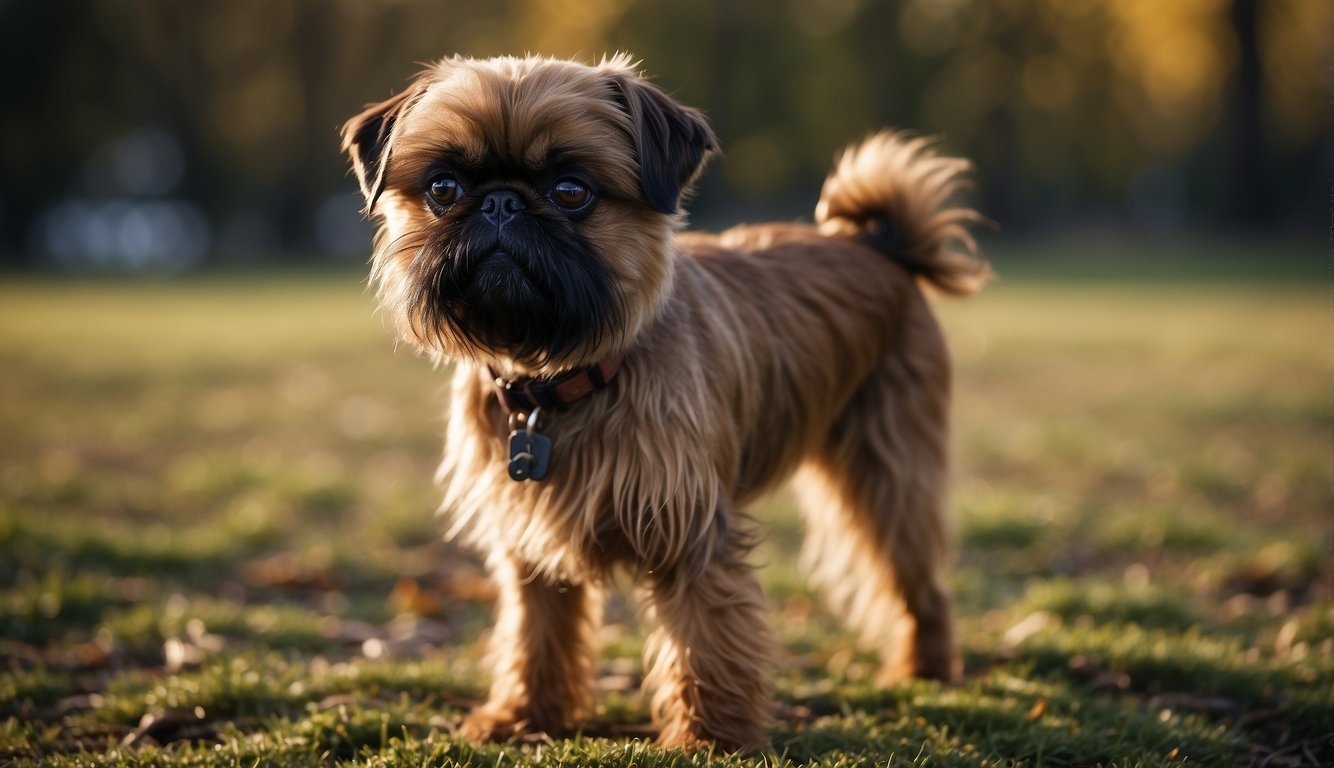
When you’re ready to welcome a Brussels Griffon into your life, finding the right source and preparing your home are crucial first steps. These petite dogs, with their affenpinscher and English toy spaniel heritage, are charismatic companions descending from the same lineage as the Pug.
Identifying Reputable Breeders
When seeking a Brussels Griffon puppy, it’s imperative to identify reputable breeders. Below are key factors to consider during your search:
- Health Clearances: Breeders should provide health clearances for both of the puppy’s parents.
- Visitation Rights: A trustworthy breeder will allow you to visit and see the living conditions of the puppies.
- Breed Knowledge: Expect detailed information about the breed’s characteristics and needs.
- After-Sale Support: Reputable breeders often offer guidance after you take your puppy home.
Here’s a checklist to help you scrutinize breeders:
- Offers a health guarantee for the puppies
- Shows familiarity with the breed’s lineage, including Pug, affenpinscher, and English toy spaniel
- Practices ethical breeding standards
- Encourages questions and provides clear answers
Preparation for Ownership
Preparing for the arrival of your Brussels Griffon involves several steps to ensure a smooth transition. Keep in mind the following:
- Space: Designate a safe, comfortable area for your puppy.
- Diet: Be ready with the right type of food, as recommended by the breeder or veterinarian.
- Exercise: Plan for daily exercise to keep your Griffon physically and mentally stimulated.
- Training: Consider basic obedience classes to establish good behavior early on.
Special Considerations
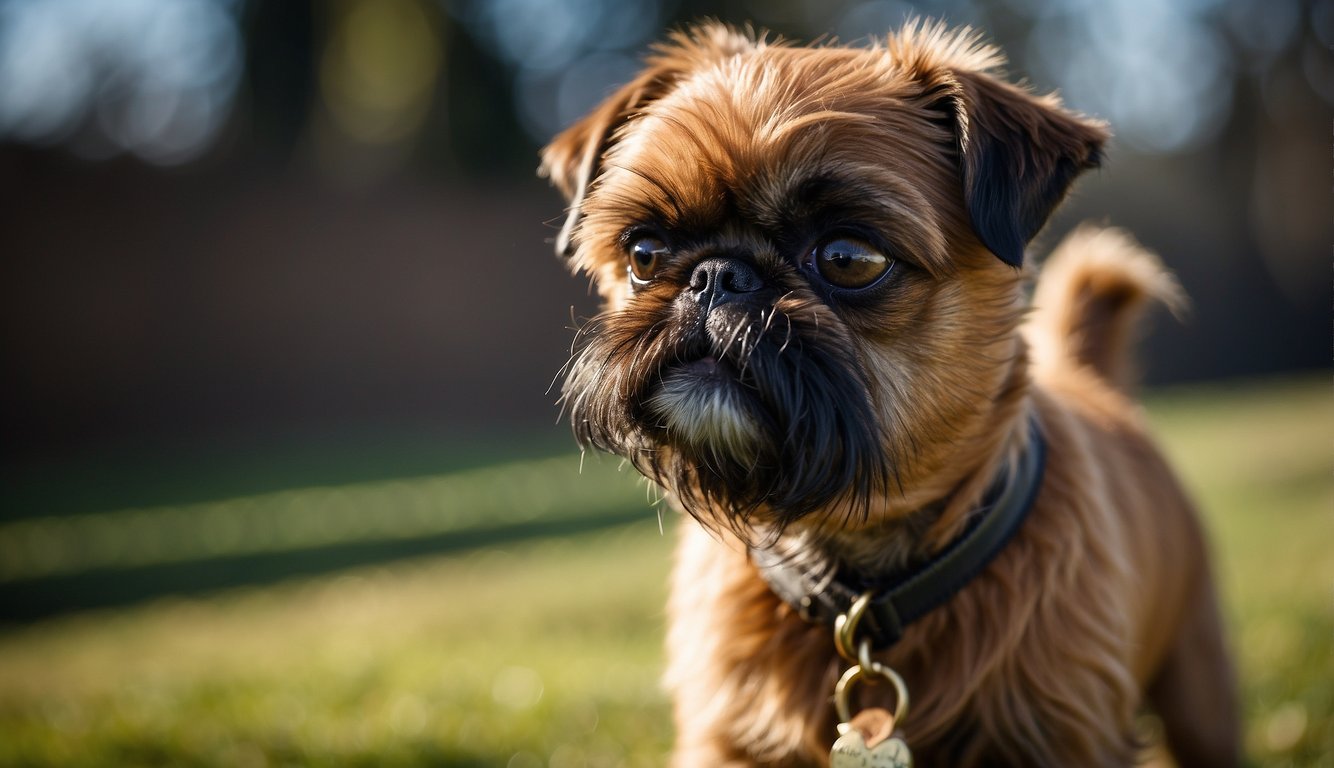
When you’re caring for a Brussels Griffon, it’s important to be mindful of their unique needs. Here are some things to consider:
Sensitivity: Your Griffon is a sensitive little companion. They often thrive on attention and can develop separation anxiety.
To prevent stress when you’re away, establish a routine and consider crate training for comfort and safety.
Brachycephalic Concerns:
- Breathing: Their short noses make them brachycephalic, which means they can have difficulty breathing, especially in hot weather or after extensive exercise.
- Dental: Due to their small jaws, dental crowding is common, so regular dental checkups are important.
Noise Level and Barking:
- Alertness: Griffons are alert and will bark to let you know of anything unusual.
- Training: Early and consistent training can help manage their barking, making it less of an issue.
| Consideration | Recommendation |
|---|---|
| Separation Anxiety | Routine, crate training |
| Brachycephalic | Avoid overheating, monitor exercise, vet care |
| Barking | Alert by nature, manageable with training |
Remember, every dog is an individual, and while these considerations are typical for Brussels Griffons, your experience may vary. Your vet can be a great partner in ensuring your Griffon stays healthy and happy.
Frequently Asked Questions
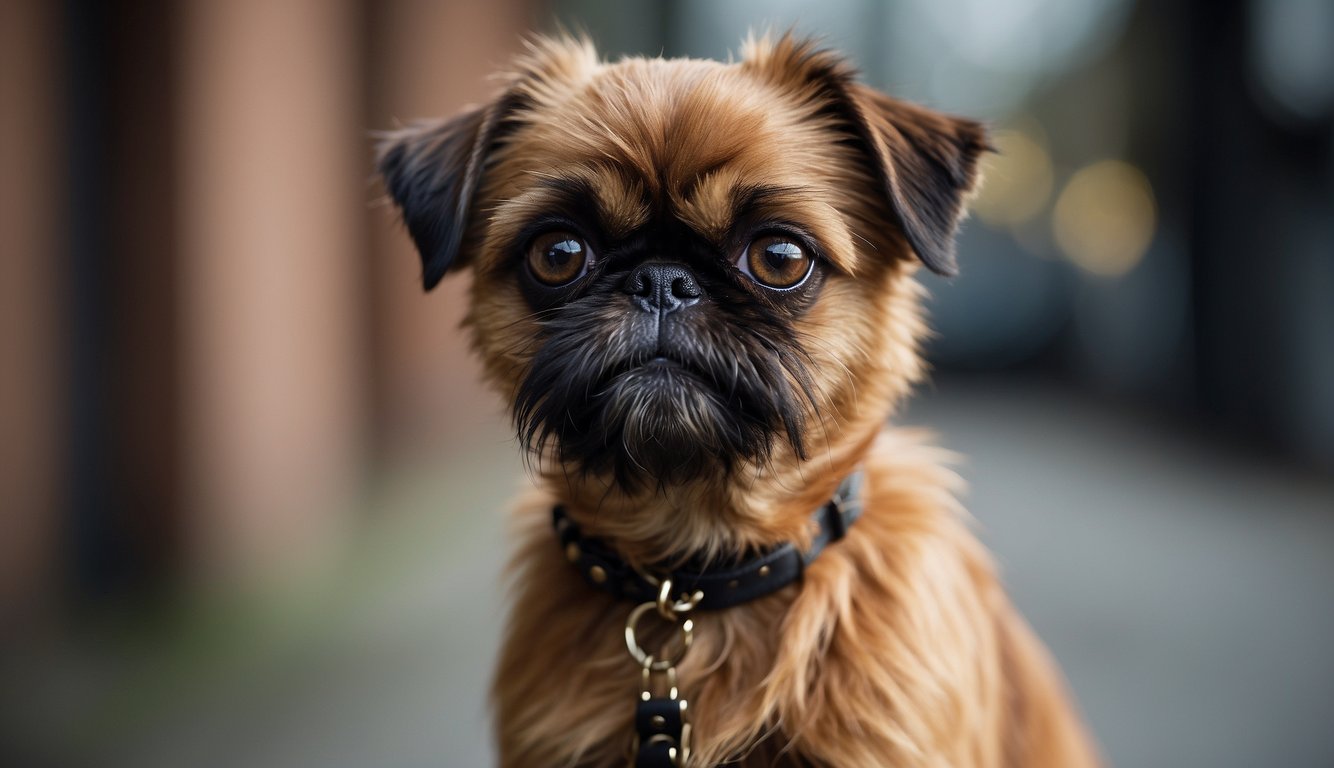
In this section, you’ll find answers to common questions about the Brussels Griffon, detailing their traits, cost, varieties, suitability for owners, behavior, and size.
What are the main characteristics of the Brussels Griffon?
The Brussels Griffon is a small dog with a sturdy build, known for their large, expressive eyes and human-like expressions. They are intelligent, alert, and have a mix of mischievous and affectionate traits, making them charismatic companions.
How much does a Brussels Griffon typically cost?
A Brussels Griffon can vary in price depending on the breeder and lineage, but you can expect to pay anywhere from $1,500 to $3,000. Costs may increase with pedigree and show quality dogs.
What are the different varieties of Brussels Griffon?
There are two coat types (smooth and rough) and several coat colors including red, black and tan, solid black, and belge which is a mix of black and reddish brown. The smooth-coated variety is known as the Petit Brabançon.
Is the Brussels Griffon breed suitable for first-time dog owners?
While Brussels Griffons are loyal and loving, their strong personalities and need for attention can be challenging. They do best with patient owners who can provide consistent training and socialization.
How do Brussels Griffons generally behave around strangers and other pets?
Brussels Griffons tend to be wary of strangers initially but can become sociable with proper introduction. They may get along with other pets, but due to their self-important nature, they sometimes do better as the only pet.
What is the average size and weight of a full-grown Brussels Griffon?
The average height of a full-grown Brussels Griffon is about 9-11 inches. They typically weigh between 5 to 15 pounds. This makes them a comfortable size for most living situations.
